The summer of 2020 , known as the “DeFi Summer,” was an incredible period for the crypto industry. For the first time, DeFi does not just stay at the theoretical level, but also plays a role in the practical level.
During this period, we witnessed the popularity of several DeFi primitives, Uniswap's DEX (decentralized exchange), Aave's lending protocol, Sky (formerly MakerDao) ecological algorithmic stablecoin, etc.
Subsequently, TVL in DeFi applications increased significantly. From approximately US$600 million at the beginning of 2020, it grew to more than US$16 billion by the end of the year, and reached an all-time high of more than US$210 billion in December 2021. This growth is also accompanied by a strong bull market in the DeFi field.

Source: DeFi Llama
There were two main catalysts behind the “DeFi Summer” at that time:
1. Breakthrough progress in DeFi protocols with ready expansion suites and clear use cases.
2. The beginning of the U.S. Federal Reserve’s easing cycle, during which the U.S. Federal Reserve aggressively cut interest rates to boost the economy. Since traditional risk-free interest rates are very low, this leaves ample liquidity in the system and incentivizes people to seek other income opportunities. This is the perfect condition for DeFi to thrive.

Source: Fred St Louis
However, like many new disruptive technologies, DeFi adoption has followed a common S-curve path, often referred to as Gartner's Hype Cycle.
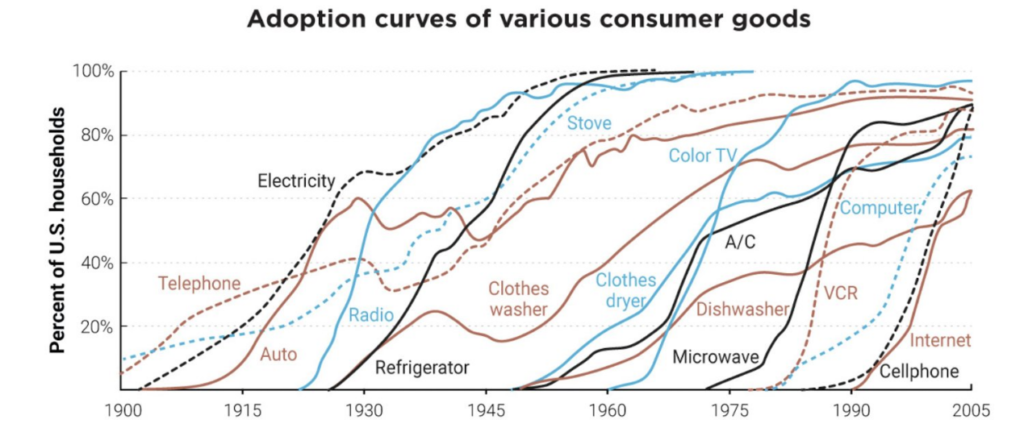
Source: The Bullish Case for Bitcoin
At the beginning of the “DeFi Summer”, early buyers had a strong belief in the transformative nature of their investments. For DeFi, the idea is that it can fundamentally change the current financial system.
However, as more players enter and enthusiasm reaches a fever pitch, buying is increasingly driven by speculators who are more interested in quick profits than in the underlying technology. After this peak of excitement, prices fell, public interest in DeFi waned, and then the market turned bearish, ushering in a lengthy period of stagnation.
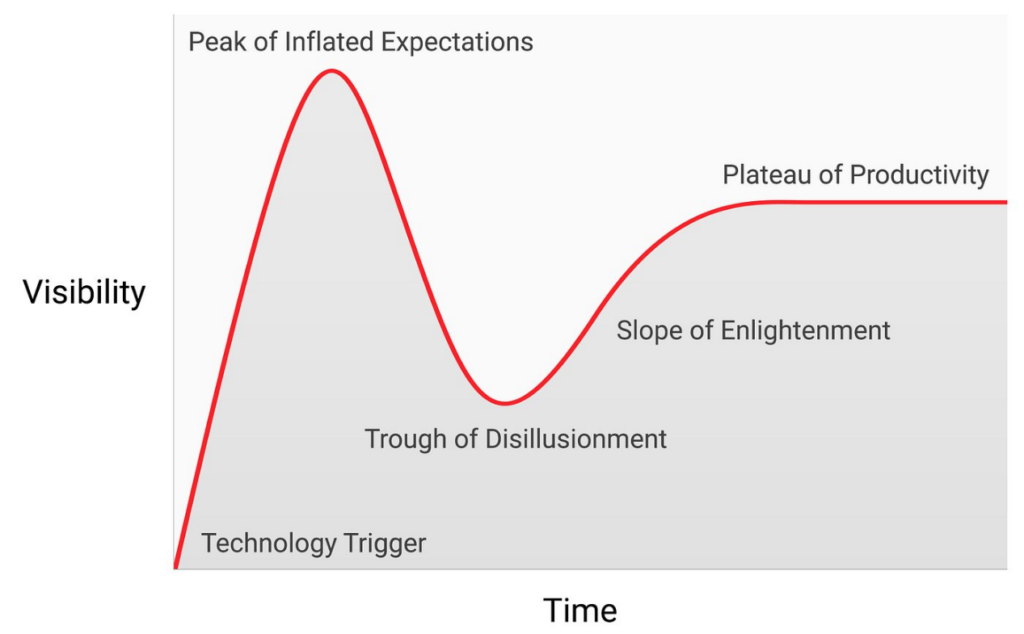
Source: Speculative Adoption Theory
However, there are good reasons to suggest that this boring period of stasis is not the end of DeFi, but the beginning of the journey towards mass adoption. During this time, developers continued development and the number of staunch believers slowly grew. This sets a solid foundation for the next iteration of the Gartner Hype Cycle, which will likely bring more adopters and greater scale.
DeFi renaissance
As of now, the prospects for a DeFi renaissance appear bright. Similar to the catalysts behind the previous round of "DeFi Summer", there are currently: a new generation of more mature DeFi protocols being built; healthy and growing DeFi indicators; the arrival of institutional players; and the ongoing US Federal Reserve easing cycle. Again, this is the perfect environment for DeFi to thrive.
Towards DeFi 2.0
Over the years, DeFi protocols and applications have grown significantly from the initial wave of hype in 2020. Many of the issues and limitations faced by the first iterations of these protocols have been addressed, resulting in a more mature ecosystem. This is the rise of what is now known as the DeFi 2.0 movement.
Some key improvements include:
- Better user experience
- Cross-chain interoperability
- Improved financial architecture
- Improved scalability
- Enhanced on-chain governance
- Improved security
- Proper risk management
We also saw the emergence of several new use cases. DeFi is no longer just about trading and lending as it was in the early days. New trends such as re-staking, liquidity investing, native yields, new stablecoin solutions, and RWA tokenization are making the ecosystem more vibrant.
But even more exciting is that new primitives are constantly being built. For example, on-chain credit default swaps (CDS) and fixed rate/term loans built on existing lending infrastructure.
Healthy and growing DeFi metrics
Since the end of 2023, we have witnessed a resurgence in DeFi activity with the emergence of a new wave of DeFi protocols.
First of all, from the perspective of TVL in the encryption ecosystem, after a long period of stability, the growth momentum has begun to recover. From $41 billion in October 2023, TVL almost tripled to a high of $118 billion in June 2024 before consolidating to its current level of around $85 billion. While still below all-time highs, it's still a significant rise. This could be the first wave of a long-term upward trend for TVL.

Source: DeFi Llama
Another interesting metric is DEX to CEX spot trading volume (which measures the relative trading activity between CEX and DEX), where a positive long-term trend has emerged, indicating that more and more trading volume is moving on-chain.
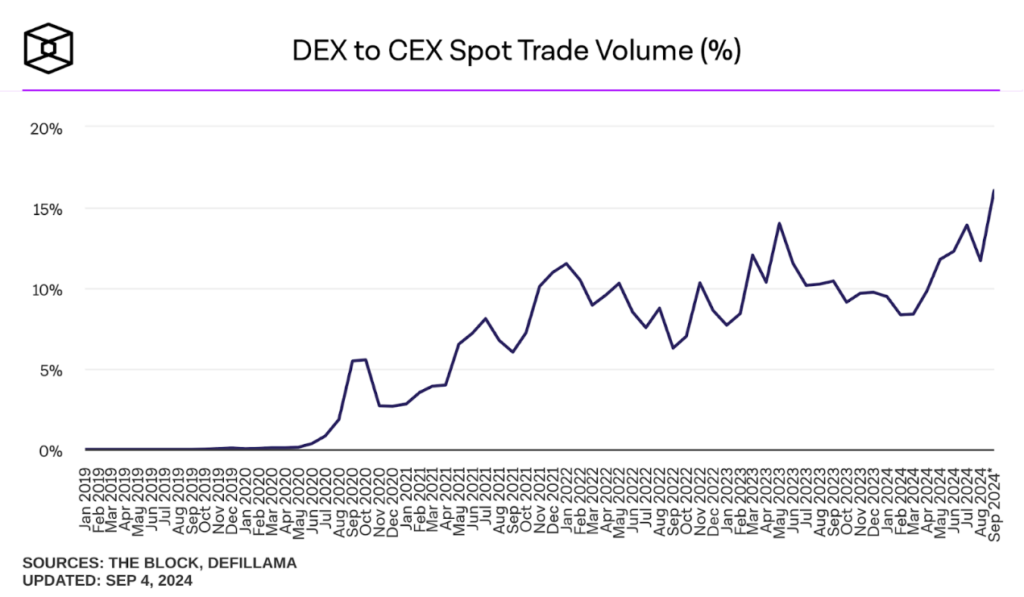
Source: The Block
And last but not least, DeFi’s market share within the broader crypto ecosystem has been rising in recent months. In a market where everyone is vying for attention, DeFi is starting to spark excitement again.
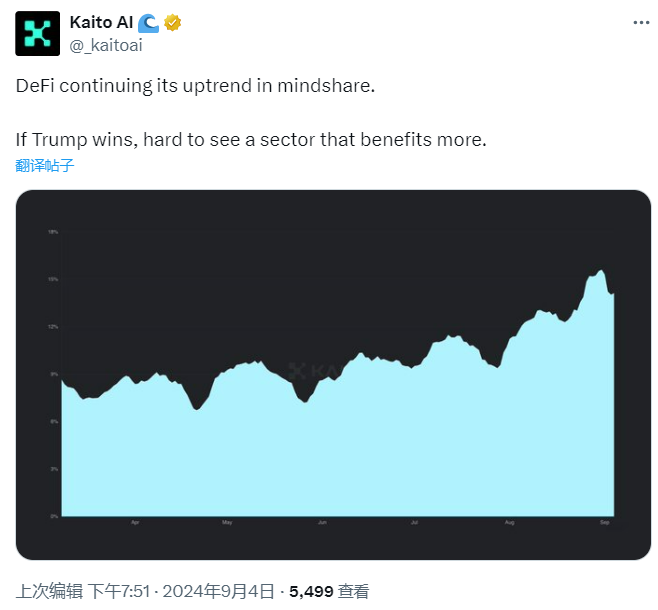
Arrival of institutional players
While the first wave of DeFi participants in the "DeFi Summer" were mostly individuals trying to grasp the power of this new technology, the new wave of DeFi protocols has begun to attract several large traditional financial institutions.
In March this year, BlackRock, the world's largest asset management company, launched the first tokenized fund on the Ethereum chain: the BlackRock USD Institutional Digital Liquidity Fund (BUIDL fund). The fund allows investors to earn U.S. Treasury yields directly on-chain and has already attracted more than $500 million.
Another notable one is PayPal’s PYUSD stablecoin, which recently reached an important milestone: a market cap of over $1 billion, one year after launch.
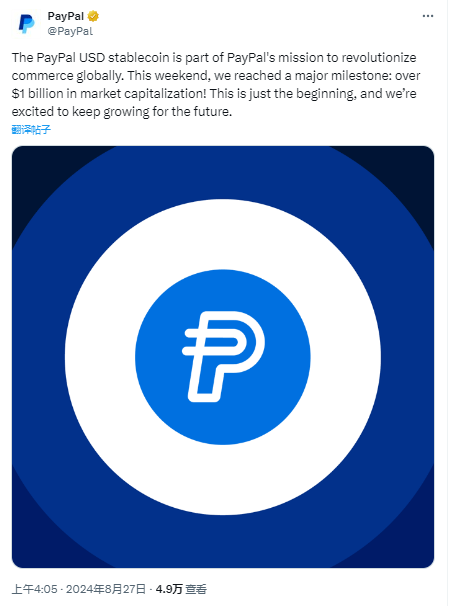
These examples show that the traditional financial industry is finally beginning to recognize the value proposition of building a financial system on decentralized blockchain technology. In the words of PayPal's chief technology officer, "If it can reduce my overall cost and bring benefits to me at the same time, why not accept it?" As more institutional players begin to try this technology, or Will become a catalyst in the DeFi field.
The U.S. Federal Reserve is entering an easing cycle
In addition to the above points, U.S. monetary policy is also another potential catalyst for DeFi. In fact, the market has just experienced a major inflection point. The US Federal Reserve cut interest rates for the first time by 50 basis points at the recent September FOMC meeting, which is a strong signal that a new easing cycle is underway. The expected path of the federal funds rate is further evidence of this.

The beginning of a new monetary easing cycle supports two key arguments for the DeFi bull market:
1. This easing cycle will inevitably increase liquidity in the system. Liquidity is a key factor in financial markets, and excess liquidity is beneficial because it means more funds can enter the market. Inevitably, DeFi and the broader crypto market will benefit from this.
2. The decline in federal funds rates will also passively increase the relative attractiveness of DeFi yields. In short, as traditional risk-free rates decline, investors will begin to seek other income opportunities. This could lead to a shift in the market toward DeFi, which offers a wide range of stablecoins and other yield strategies that are more secure and reliable than they were just a few years ago.
Will history repeat itself?
All in all, various factors seem to be pointing towards a DeFi recovery.
On the one hand, there are several new DeFi primitives that are more secure, scalable and mature than they were a few years ago. DeFi has proven its resilience and become one of the few crypto tracks with mature use cases and real adoption.
On the other hand, similar to the situation in the last round of "DeFi Summer", the current monetary environment is also supporting the recovery of DeFi. DeFi indicators suggest that we may be at the beginning of a larger uptrend.
History never repeats itself, but it always rhymes.







